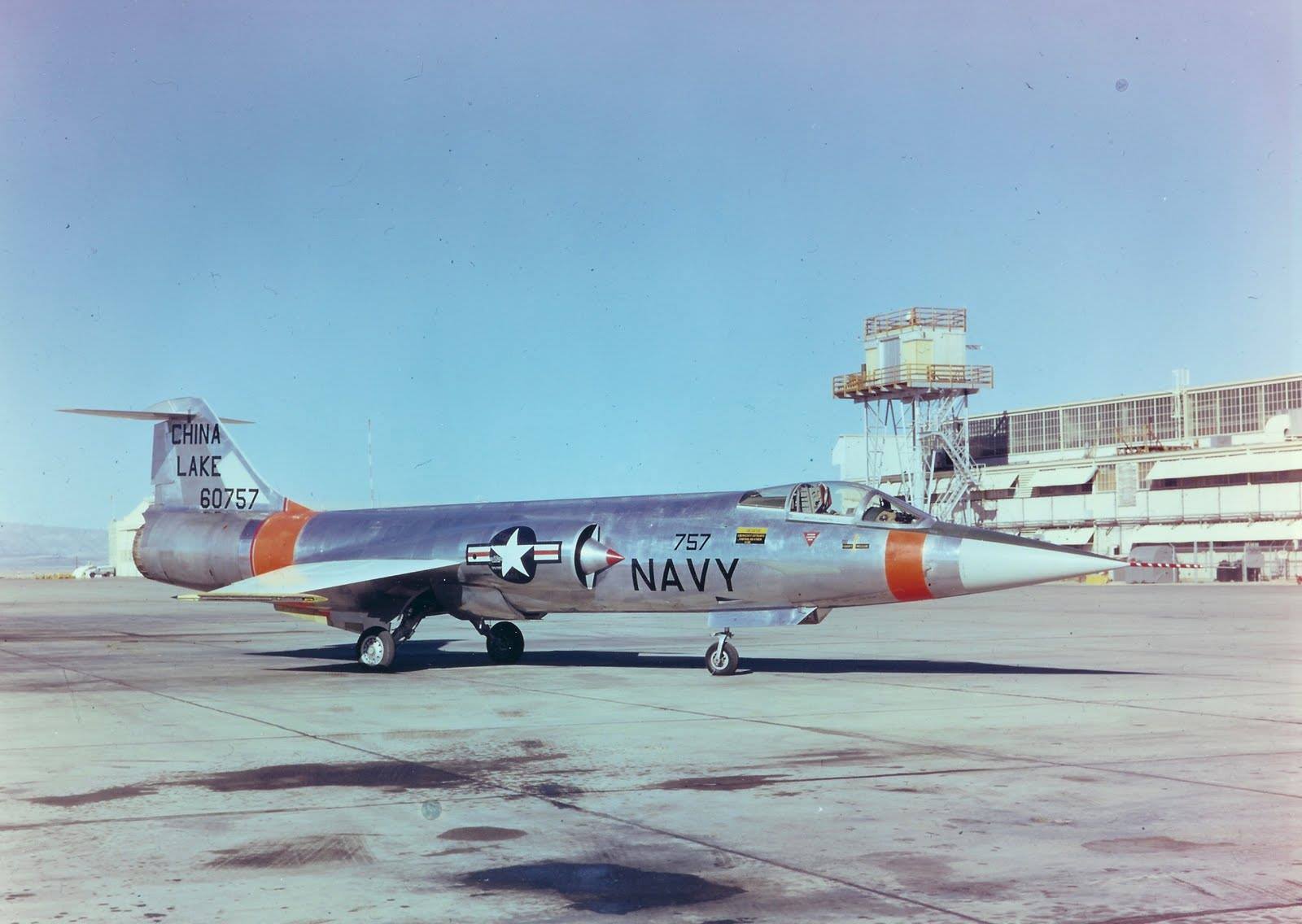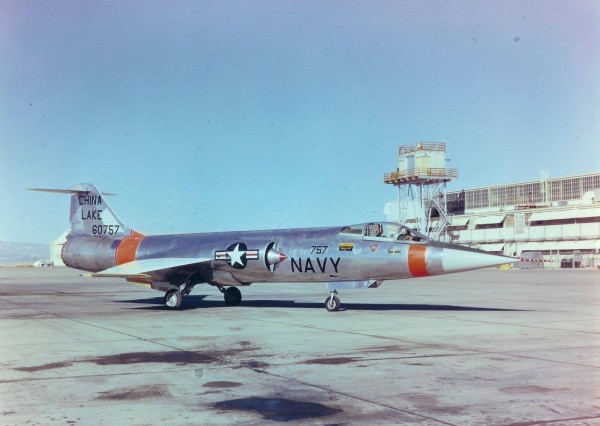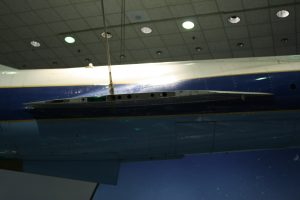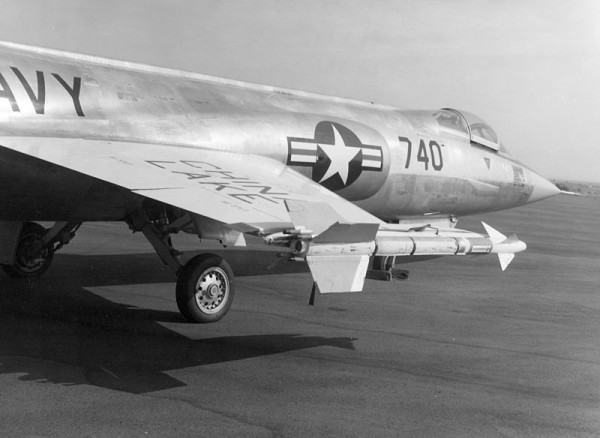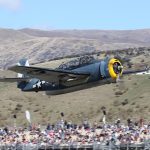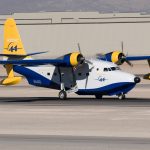Both the USAF and the US NAVY throughout the years have tested different types of aircraft that we not originally developed for their branch. The “NAVY F-104” is surely one of those very interesting trials. It was project that nearly came to fruition in the late 1950’s was the incorporation of the F-104 into U.S. Navy service. The Navy felt the need to have a defensive fighter with a high speed capability, and one of the fastest aircraft was the U.S. Air Force F-104 Satrfigher, a considerably higher performing aircraft than the Navy F3H Demons which were soon to be phased out of front line service.
With the concerns of a relatively tight defense budget, the costs incurred for a new design were much too high for a totally new aircraft to be created. However The US NAVY didn’t have to wait that long before to have its high performance fighter.On 30 December 1960, the VF-121 “Pacemakers” at NAS Miramar became the first Phantom operator with its F4H-1Fs (F-4As). The VF-74 “Be-devilers” at NAS Oceana became the first deployable Phantom squadron when it received its F4H-1s (F-4Bs) on 8 July 1961
Accordingly to Terry Moore of Internet Modeler, the Navy procured 2 F-104’s from Lockheed and modified them for naval use. The two aircraft received the designation XF5V-1(F-104E) on April 1, 1960. The modifications were designed by Lockheed project engineer A.P. Rilfool and included general strengthening of the main landing gear, extending the length of the nose wheel gear to increase angle of attack on takeoff, extending the wing tips slightly as well as giving them the capability of being folded. The F-104 central ventral fin was replaced by twin ventral fins offset from the center line of the aircraft, and the arresting hook was strengthened to allow for deck landings. The canopy was redesigned to hinge from the rear, instead of from the side, as per the Air Force counterpart. Nowadays a F-104 landing on an aircraft carrier is very hard to imagine but back in those days engineers were trying all kind of solutions.
The aircraft were transported to NOTS China Lake and assigned to AIRDEVRON 5. First flight was made by the second aircraft on April 1, 1961 and was flown by Cmdr I. B. Fulenya. Problems with the first aircraft delayed its first flight for several weeks and finally took to the air with Lt I. M. Joshin at the controls. Both aircraft went through a battery of tests at China Lake including catapult launches and deck landing training in anticipation of actual deck trials later in the year. Results were promising, however, a production order was not forthcoming, primarily due to problems with the extended wing tips and their susceptibility to failure with very hard deck landings.
Martin Bowman, author of “Lockheed F-104 Starfighter” from Crowood Press Ltd in his book commented that the F-104 featured a radical wing design. Most jet fighters of the period used a swept-wing or delta-wing planform. This allowed a reasonable balance between aerodynamic performance, lift, and internal space for fuel and equipment. Lockheed’s tests, however, determined that the most efficient shape for high-speed, supersonic flight was a very small, straight, mid-mounted, trapezoidal wing. The new wing design was extremely thin, with a thickness-to-chord ratio of only 3.36% and an aspect ratio of 2.45. The wing’s leading-edges were so thin (0.016 in/0.41 mm) and sharp that they presented a hazard to ground crews, and protective guards had to be installed during ground operations. The thinness of the wings required fuel tanks and landing gear to be placed in the fuselage. The hydraulic cylinders driving the ailerons had to be only 1 inch (25 mm) thick to fit. The wings had both leading- and trailing-edge flaps. The small, highly-loaded wing resulted in an unacceptably high landing speed, so a boundary layer control system (BLCS) of blown flaps was incorporated, bleeding engine air over the trailing-edge flaps to energize airflow over the flaps and thus improve lift. The system was a boon to safe landings, although it proved to be a maintenance problem in service, and landing without the BLCS could be a harrowing experience.
Accordingly to Terry Moore on at least two occasions, one or both extended wing tips failed at China Lake while landing. The problems could not be rectified without a major redesign of the entire wing. Consequently, actual carrier deck landing trials were cancelled, as was the entire project on April 1, 1962. The 2 aircraft remained at China Lake for some time and their ultimate fate is unknown to this day.
The picture above,published on Wikepedia, shows the U.S. Navy Lockheed F-104A-5-LO Starfighter (USAF s/n 56-740) carrying a Sidewinder 1-C missile at the Naval Air Weapons Center China Lake, California (USA), on 29 July 1960. The Sidewinder 1-C was developed into the Sidewinder 1C Mod 30 (AIM-9C) with an semiactive radar head (SARAH), and the Sidewinder 1C Mod 29 (AIM-9D) with an infrared alternative head (IRAH) seeker.The F-104A 56-740 crashed into a mountain north of Los Angeles on 22 September 1960. The pilot, Capt. Harold O. Casada Jr., was killed.
After further investigation it turned out that Terry Moore’s article on Internet Modeler was an Aprils Fools Day story. We have decided to keep it anyway. Below what we have found.
— Quote from: Clioman on January 30, 2009, 03:28:38 pm —An XF5V-1?
By great coincidence, the winter ’08 issue of The Hook magazine (pub’d by the US Navy’s Tailhook Association) has mention of what is claimed to be an XF5V. (Copy below) Yes, there were several F-104As at NAS China Lake; their website has photos of 3 different airplanes in the 1958-1960 timeframe, including pics of this aircraft (56-0757). But the website makes no mention of it being modified, let alone to the extent mentioned in the article. This is a new one to me, and I can find no other reference to it. Anybody have further info/confirmation. And, as the Hook editor asks, ‘what happened to the F2V, F3V and F4V?’ I’ve never heard of them, either…
— End quote —
Quote from Terry D. Moore
Gentlemen:
Not to put too fine a point on this but the XF5V-1 information as published in winter ’08 edition of The Hook appears to be based on an article I wrote for the April, 2004 edition of Internet Modeler. The XF5V-1 is a total work of fiction and even though the Navy flew a few F-104′s they were never designated as the XF5V-1. No F-104′s were modified. No extended wings, no twin ventral fins, no aft opening canopy, no heavier arresting hook. The only F-104 so modified was a Hasegawa 72nd scale kit that I built for the article. Do a google search for April 2004 Internet Modeler/Lockheeds for the Navy. One of the giveaways that this is an April Fools joke are the pilots “associated” with the project: I.B. Fulinya, A. P. Rilfool and so on. Funny, a similar thing happened on a subsequent April issue of IM about the P-47′s that Israel flew…Oh well
Terry D. Moore







